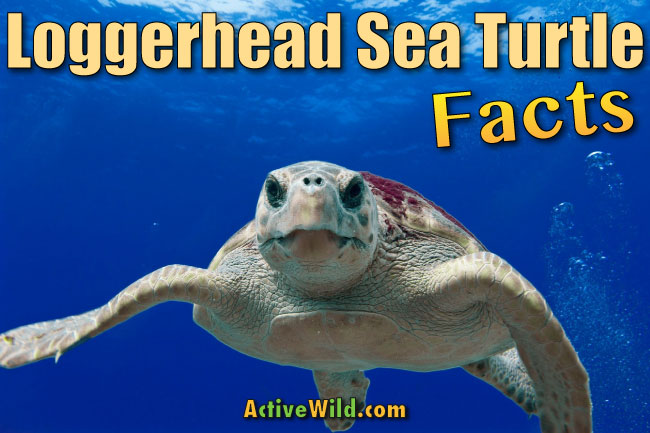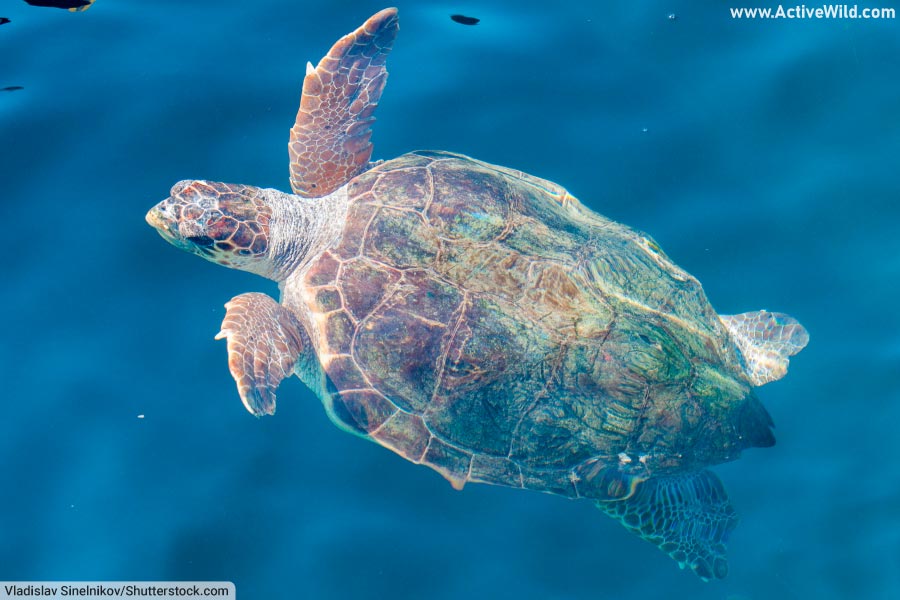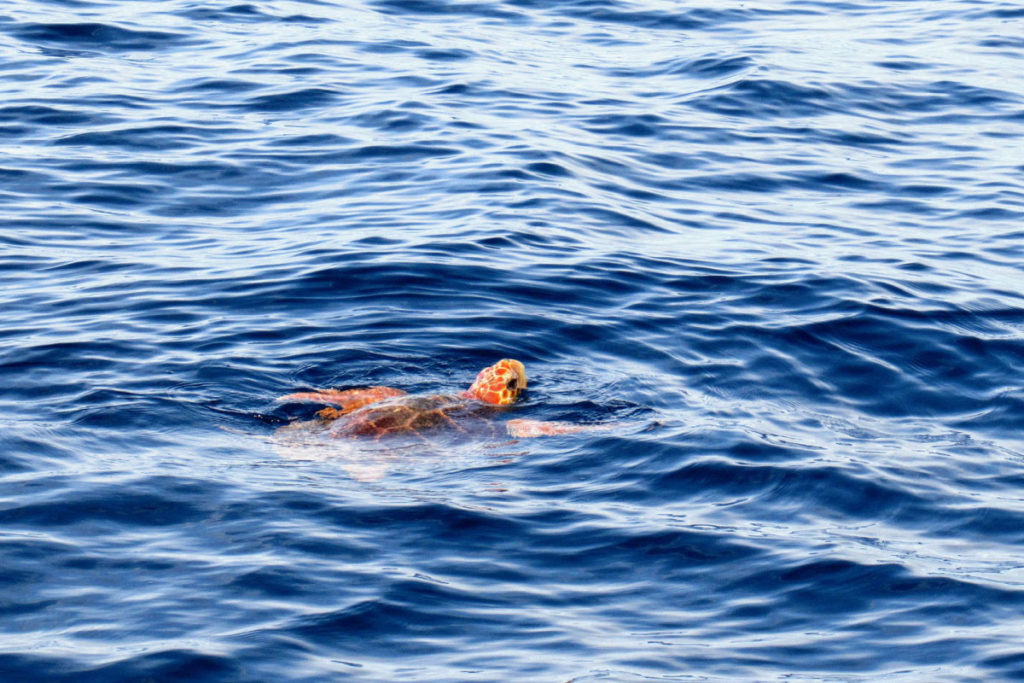Loggerhead sea turtle facts, pictures and information for kids and adults. The loggerhead sea turtle is the second-largest of the seven species of sea turtle. Although found in many parts of the world, the loggerhead's conservation status is 'Vulnerable'. Read on to get the lowdown on this threatened ocean voyager …
Loggerhead Sea Turtle Facts At A Glance
- Other Name(s): Loggerhead
- Scientific name: Caretta caretta
- Type of Animal: Reptile, Sea Turtle
- Animal Family: Cheloniidae
- Where Found: Oceans worldwide
- Length: Average 90 cm (35 in); Maximum 280 cm (110 in)
- Weight: Average 135 kg (298 lb); Maximum 545 kg (1,202 lb)
- Conservation Status: Vulnerable
- Other interesting loggerhead sea turtle facts: The turtle has glands near its eyes which excrete excess salt. On land it can look as if the turtle is 'crying'.
Meet The Loggerhead Sea Turtle: Introduction
The loggerhead sea turtle is a marine reptile. It is the largest hard-shelled turtle and the second largest turtle in the world after the leatherback sea turtle (Dermochelys coriacea). (The leatherback turtle has got a soft shell.)
The global loggerhead sea turtle population is divided into 10 subpopulations, all of which differ in their genetic makeup and physical characteristics.
What Does The Loggerhead Sea Turtle Look Like?
You can see amazing underwater footage of loggerhead sea turtles in the video below ...
Compared to other sea turtles, the loggerhead sea turtle has a large head and powerful jaws.
The carapace (the shell covering the back of the turtle) is typically reddish brown in color, while the plastron (the shell covering the underside of the turtle) tends to be pale yellow. The rest of the body ranges in color from yellowish orange to brown. The color of the hatchlings is usually reddish to dark brown.
Adult males have wider, flatter carapaces, thicker tails, and longer claws than females.
Distribution
The loggerhead sea turtle is found in temperate and tropical oceans worldwide.
Major nesting areas include the southeastern coast of North America and the Gulf of Mexico (Atlantic Ocean), Oman (Indian Ocean), Eastern Australia and Japan (Pacific Ocean) and Greece (Mediterranean).
Habitat
The loggerhead sea turtle inhabits saltwater and estuarine habitats, including the open ocean and shallow coastal waters. Hatchlings inhabit mats of Sargassum algae that float in warm ocean currents. Juveniles are found in coastal waters more often than non-nesting adults.
Only nesting females come ashore to nest on sandy beaches; once male hatchlings enter the sea, they never again return to the land.
Migrations
Like all reptiles, the loggerhead sea turtle is ectothermic (cold-blooded). This means that it has no physical means to alter its body temperature other than simply swimming to a different area (i.e. it can’t shiver to keep warm like mammals).
The loggerhead sea turtle becomes lethargic at water temperatures between 13 and 15 °C (55 and 59 °F). If the temperature drops further to around 10 °C (50 °F) then the species can become ‘cold stunned’. When this occurs the turtle can barely swim, and floats near the surface where it is vulnerable to boat strikes or to becoming beached on the shore.
To avoid cold stunning, loggerheads resident in temperate waters migrate to tropical and subtropical waters during the winter months.
Adult loggerheads also migrate between feeding grounds and nesting areas. The turtles use magnetic navigation to return to the same nesting area again and again.
Behavior
The loggerhead sea turtle is usually active during the daylight hours. The turtle spends roughly 85% of the day submerged, coming to the surface to breathe every 15 to 30 minutes on average. Longer dives can last up to 7 hours.
Aggression between individuals is common. Females fight over access to good feeding grounds; males attack each other during the mating season. Conflicts begin with threat displays. These may then escalate to physical fights, with the turtles snapping at each other's jaws.
Breeding
Loggerhead sea turtles will have reached sexual maturity by the time their carapace exceeds 90 cm (35 in) in length. This usually occurs between 17 and 33 years of age.
The breeding season takes place over 6 weeks in the early summer. The male loggerheads may nuzzle, bite and gesture to the females with head and flipper movements during courtship.
Typically, a female will nest 2 to 5 times during one breeding season. She will then produce no eggs for the next 2 or 3 years. It's possible for a female to store sperm from several males, and a single clutch of eggs may have up to 7 fathers.
The eggs incubate in a chamber excavated by the female for 45 to 80 days. The sex of the hatchlings is determined by the temperature in the nest. Cooler temperatures of about 24 to 26 °C (75 to 79 °F) produce males; warmer temperatures of about 32 to 34 °C (90 to 93 °F) produce females. Temperatures in-between these produce a mix of male and female hatchlings.
Newly-hatched young are about 4.6 cm (1.8 in) long and weigh roughly 20 g (0.7 oz). The hatchlings emerge during the night and find their way to the sea by moving towards the light of the moon and the stars reflected off of the water's surface.
What Do Loggerhead Sea Turtles Eat?
The loggerhead sea turtle is an omnivore (i.e. it eats both plant matter and meat). It preys on a wide range of animals, and also eats algae. The bulk of its diet is made up of various bottom-dwelling invertebrates. These include bivalves and gastropods, which the loggerhead crushes with its strong jaws.
Other known prey animals include jellyfish, squid, insects, fish and even hatchling turtles.
Loggerhead Sea Turtle Predators
Young loggerhead sea turtles are vulnerable to numerous predators both on land and in the sea. Eggs and new hatchlings are hunted by crabs, snakes, rats and seabirds among many others. In the ocean, various fish species and crabs prey on young loggerheads.
Their large size, shell and tough scales protect adult loggerheads from most predators. However, they are still vulnerable to big sharks, seals and killer whales.
Is The Loggerhead Sea Turtle Endangered?
The loggerhead sea turtle is rated 'Vulnerable' by the IUCN.
The rating is given to the global population; the status of individual subpopulations varies greatly.
The most significant threats faced by the loggerhead sea turtle are:
- Fisheries by-catch: In the open ocean loggerheads are frequently trapped in fishing gear such as gillnets and long lines.
- Disturbance to nesting: Construction, beach modification and other forms of coastal development interfere with nesting. Artificial lights can also confuse hatchlings and prevent them from reaching the water.
- Hunting: Humans capture loggerheads and collect their eggs to eat or to turn into commercial products, though worldwide legislation has limited the practice.
Other dangers faced by the loggerhead sea turtle include pollution, marine debris, pathogens and climate change.
Loggerhead Sea Turtle Facts: Further Reading
- You can find out more about sea turtles on this page: Sea Turtle Facts
- Discover amazing turtle species from all around the world on this page: Types of Turtles
- Find out more about turtles on this page: Is a Turtle a Reptile... and Why?
- Visit this page to become a reptile expert: Reptiles - The Ultimate Guide
Discover other sea turtle species:
- Flatback Sea Turtle Facts
- Green Sea Turtle Facts
- Hawksbill Sea Turtle Facts
- Kemp’s Ridley Sea Turtle Facts
- Leatherback Sea Turtle Facts
- Olive Ridley Sea Turtle Facts
See pictures and facts about amazing animals from all around the world here: A to Z Animals






I have a caiman turtle shell that I inherited. What are the legals on resale this shell.
Hi Patricia,
Thank you for your message. Unfortunately we can’t give specific information on this matter. Assuming you’re from the US, this U.S. Fish & Wildlife document may help.
It may be worth getting in touch with the Fish and Wildlife Service for specific guidance.
I hope this helps.